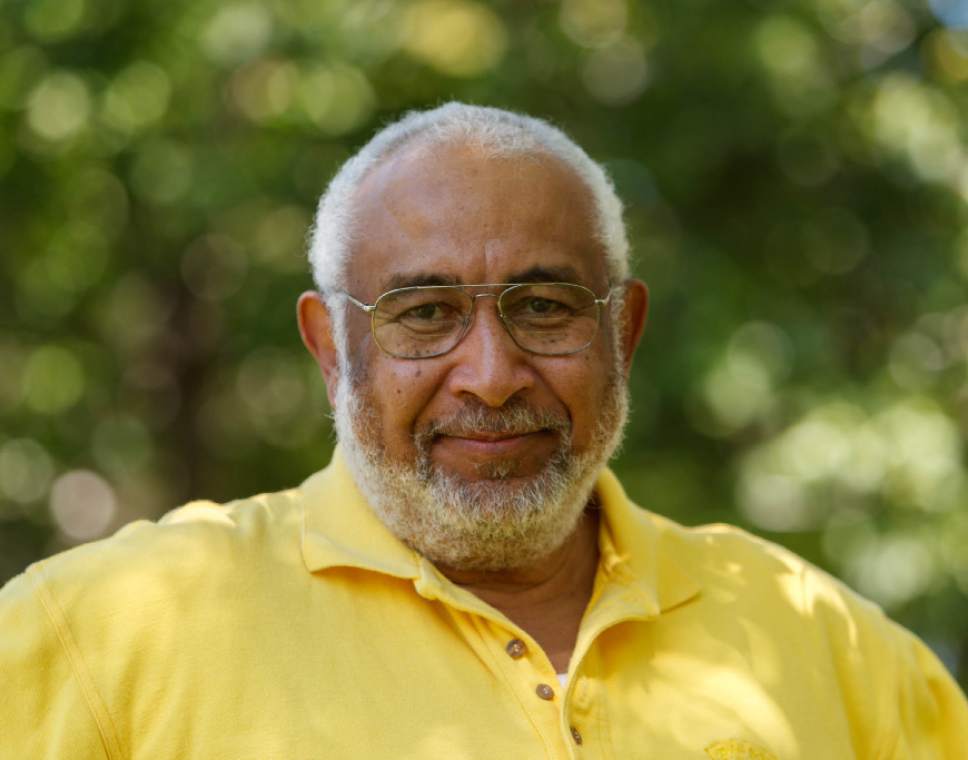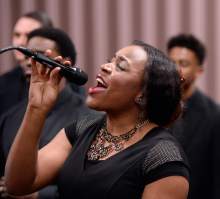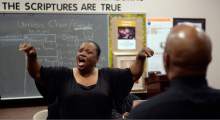This is an archived article that was published on sltrib.com in 2017, and information in the article may be outdated. It is provided only for personal research purposes and may not be reprinted.
Tamu Smith was called the N-word in the Salt Lake LDS Temple a week after her wedding day more than 20 years ago. The same slur was aimed at Zandra Vranes in April on her Facebook page by a temple-going Mormon.
In both cases, the women were advised to forgive the offense, take the high road and focus on the positive.
That approach, however, has hidden rather than solved latent racism in LDS Church ranks, says Vranes, co-author with Smith of "Diary of Two Mad Black Mormons."
Thursday marks the 39th anniversary of The Church of Jesus Christ of Latter-days Saints ending its long-standing ban on blacks being ordained to its all-male priesthood and black women being barred from its temples. But some Mormons argue that their church is still grappling with racism and that failure to face the nagging problem head-on looms as a roadblock.
Black members routinely endure slurs, stereotyping, shunning and insulting assumptions ("You only got into Brigham Young University because you're black") — even from fellow believers.
No matter how devout they are, many Mormons of color say they struggle to escape outsider status in their largely white religion. And tensions have been heightened, they say, in a deeply divided nation, awash in personal attacks online and competing protests in the streets.
Last weekend, a group of white Mormon nationalists verbally assaulted Vranes and Smith on Twitter. Some defended the duo, who blog under the label "Sistas in Zion," while others joined the so-called alt-right side, whose devotees bemoan what they see as growing — and unfortunate — diversity in the global faith.
The latter Mormons apparently feel "there is room for them in the church," Smith says. "If the brethren [high-ranking church leaders] don't speak up, it's only going to get worse."
And not just the leaders. The church, she says, will be stuck with racial conflict until the members, who make up the "body of Christ," take action.
When white Mormons heard the June 8, 1978, announcement extending the priesthood to all worthy black men and boys, many wept for joy.
What were they doing the day before, besides supporting the status quo? Vranes wonders. They "never learned to stand up against wrong."
—
Unspooling the past • That spring day 39 years ago was momentous for the LDS Church, celebrated by the vast majority of Mormons as a clear example of divine revelation.
Latter-day Saints everywhere recognized the move as a game-changing milestone. It opened the door for wider proselytizing in Africa and other continents with black populations, and allowed Mormonism to woo potential believers in far-flung regions previously off-limits because of the priesthood prohibition.
Yet dropping the ban did not — indeed could not — eliminate all racism in the church.
LDS leaders offered no apology nor, at the time, any in-depth analysis of the reasons for the exclusionary policy. Justifications, including the notion that blacks were descendants of a biblical bad guy, Cain, or that they were less valiant in a premortal existence, continued to be taught and touted by members. Statements dismissing or denigrating blacks offered by previous Mormon authorities remained in print and often were embraced by believers long after the ban's demise.
Racial strife — including slurs and denigrating remarks — still "lifts its ugly head ... even right here among us," President Gordon B. Hinckley preached in a 2006 LDS General Conference address. " ... I remind you that no man who makes disparaging remarks concerning those of another race can consider himself a true disciple of Christ."
During Mormon Mitt Romney's 2012 presidential campaign, church officials categorically condemned all the so-called justifications used to defend the previous priesthood prohibition.
A year later, the Utah-based faith issued a landmark essay on "Race and the Priesthood," which laid much of the blame for the policy on societal racism during the 19th century when Mormon prophet Brigham Young formalized the exclusion. In the church's early days, under LDS founder Joseph Smith, who openly opposed slavery, a few black men were ordained to the priesthood.
The essay, though not without its critics, went a long way toward helping African-American Mormons grapple with their church's history. But it was published online, rather than read over the pulpit, which means many members still know little about it.
To counterbalance any racist vestiges, Mormon officials began a conscious campaign to boost "diversity (including race) in church publications and messages," LDS Church spokesman Eric Hawkins notes. "Materials today seek to represent a much more global church."
Hawkins reiterates Hinckley's statement from a decade ago as the church's definitive position — and Brigham Young University sources say the race essay soon may become required reading for freshmen. The faith's flagship school discusses diversity across the disciplines, while actively recruiting black students.
Black Mormons say it is not enough.
—
Pulling off the scab • The church's "race problem" is "much larger and runs much deeper than most of us would like to admit," says Bryndis Roberts, a black Mormon in Atlanta who blogs at Femwoc (Feminist Women of Color).
The source of LDS racism, she says, can be found "in its teachings, its actions and its inactions."
Racial beliefs common to 19th-century Christians spawned the ban, prompted Mormon leaders "to write and speak about their sense of repulsion at the thought of touching black skin during temple ceremonies ... and to have missionaries searching through the personal items of potential members to determine if they had any black blood ... and to teach against marrying outside of one's race."
It then should be no surprise, Roberts says, when today's alt-right Mormons spew racial hatred.
While members of color "have to learn about white people in order to survive in this world, there is no such requirement for white people," she says. Thus "they fail to cast aside their preconceived notions, stereotypes and tropes about people of color."
LaShawn Williams, a black Mormon scholar at Utah Valley University in Orem, goes even further.
"Persistent racism in the church is the result of internalized white supremacy," she says. "After the government passed civil rights legislation, we continued exclusionary practices in leadership and ordinances for eternal progression."
Here's what happened during the ban's existence, she says. "Black parents, black women and black men could not serve missions or marry in the temple. We could get baptized. That was it. The first thing missionaries commit all investigators to do en route to the temple was the first and last thing black people could do until June 8, 1978."
LDS leaders and members, she says, should explore this "historical narrative."
When black men held the priesthood under Smith and served limited missions in the early church, Williams says, that "was more in line with bold Mormonism."
White members need to "own [the] fear-based decisions that led [them] to support and promote anti-black racism in the U.S.," she says. "To do anything less makes hypocrites out of all of us trying to love in Christ's name."
—
Uncomfortable conversations • Many black Mormons argue that the key to a more inclusionary future runs through the exclusionary past.
"We have to be real about our history," says Phylicia Rae Jimenez, a black Mormon in Philadelphia. "Members must understand what the essay means — that the ban was not of God."
It is essential for top church authorities to address "the ban and racism in the church," Jimenez says, by teaching the topic from the pulpit and in Sunday classes.
"We cannot begin to move forward," she says, "until the amount of talks given today outweigh and outnumber the racist talks that were given in the past."
Writer Janan Graham-Russell, a Mormon graduate of the Howard University School of Divinity, agrees.
"White Mormons will really need to look at the racial policies and white supremacist ideologies that made their way into LDS theology," Graham-Russell says. "I genuinely believe there are people who don't know and/or don't want to know why the restrictions took place."
Nor, she says, do they think of themselves as racists.
That may only change, Graham-Russell says, if Mormon leaders offer a "clear and churchwide ... repudiation of [past] racial policies."
The theologian would also like to see her church teach "racism as sin."
"We talk about [unmarried] sex being akin to murder ... but not racism?" Graham-Russell says. "Racism is detrimental to physical and spiritual progress, as we've seen with state-sanctioned violence and the socioeconomic inequalities among communities of color. Why is it not a core part of church teachings? "
Darron Smith, a black writer and author of "When Race, Religion and Sport Collide: Black Athletes at BYU and Beyond," is unequivocal about his prescription for healing: It won't happen without a formal and public apology for the priesthood ban over the pulpit by the Mormon prophet at LDS General Conference.
—
Future approaches • One of the issues for many African-American Mormons is their invisibility in their faith community.
There are black general authorities, but no black apostles, no blacks in the general presidency of the women's Relief Society, few in the famed Mormon Tabernacle Choir or as faculty at BYU. LDS art often features a Scandinavian-looking Jesus and the biblical Adam and Eve are most often depicted as white.
Nor are their contributions to Mormon history recognized by many fellow believers.
That's why it was gratifying for black Mormon genealogist Alice Faulkner Burch last month when a Mormon pioneer slave was honored.
In the 19th century, Brigham Young sent two Bankhead families to settle the town of Wellsville in Cache County: the white Bankheads and the African-American Bankheads, whom they owned.
"As years passed, the latter became forgotten as pioneers, their names blew away with the dust," Burch says. "Once-marked graves were so repeatedly vandalized that headstones no longer stood to designate who lay beneath."
On May 27, Wellsville erected a monument to the black Bankheads and held a program to honor them. At the end, Frank Bankhead, a descendant of the African-American family, and Evan Bankhead, a descendant of the white family, walked together to the monument and placed potted flowers.
Nothing could be more symbolic.
Remembering pioneering black Mormons, making their stories as well-known and well-loved as the hymn "Come, Come, Ye Saints," while acknowledging the existence of racism, renouncing the past and accepting responsibility for any wrongs would go a long way toward salving the still-open wounds, says Darius Gray, former branch president of the Genesis Group, a support organization for black Mormons.
It would be a balm for both blacks and whites, he says, transforming them into true brothers and sisters.
Twitter: @religiongal —
How to enhance race relations
Here are some suggestions that have been raised, mostly by black Mormons, for how the LDS Church could improve race relations within the faith.
• Cast a black Adam and Eve (or an interracial couple) in the film shown to faithful members in LDS temples.
• Use more African-American faces in church art and manuals and display more artwork depicting Christ as he would appear: as a Middle Eastern Jewish man.
• Pick more blacks for highly visible leadership positions — if not an apostle, at least in the general authority Seventy or in the general auxiliary presidencies.
• Repudiate and apologize for the faith's past priesthood/temple ban on blacks, which the church lifted in 1978.
• Show the documentary film "Nobody Knows: The Untold Story of Black Mormons" to every all-male priesthood quorum, women's Relief Society class and Young Men and Young Women groups.
• Quote from the church's Gospel Topics essay "Race and the Priesthood" regularly at LDS General Conference and translate it into all the languages that the church uses to communicate with its global membership.
• Direct that the essay be read from the pulpit in every Mormon congregation and mission in the world.
• Have the Book of Mormon scripture found in 2 Nephi 26:33 — "All are alike unto God" — be a yearlong Young Women or Primary theme and make it part of the curriculum to talk about the sin of racism.
• Bring more blacks to LDS Church-owned Brigham Young University as students and faculty, while providing sensitivity training for all students about racial issues and interactions with people of color.
• Teach children about the heroic black Mormon lives, such as LDS pioneers Jane Manning James and Elijah Abel.
• Expand the LDS hymnbook to include more diverse songs and styles.
• Enlist more people of color in the Mormon Tabernacle Choir.
• Invite the choir from the Genesis Group — a longtime Utah-based support organization for black Mormons and their families — to sing at General Conference.
• Use the Genesis Group to assist in improving relationships with the African-American community.
• Give the Genesis Group greater authority to exist in all states and to visit wards and assist lay bishoprics in how to avoid and overcome racism in their congregations.
• Create a church-sponsored Mormon and black website akin to the one found at mormonandgay.org.
• Treat the members of the Genesis Group's presidency as an auxiliary, seating them on the stand with other high-ranking authorities during General Conference — and invite at least one of them to speak during the sessions.
• Provide training on racial issues for newly called mission presidents.
• Include a mandatory class at Missionary Training Centers that teach the "Race and the Priesthood" essay so missionaries are better prepared when they go out to preach.













